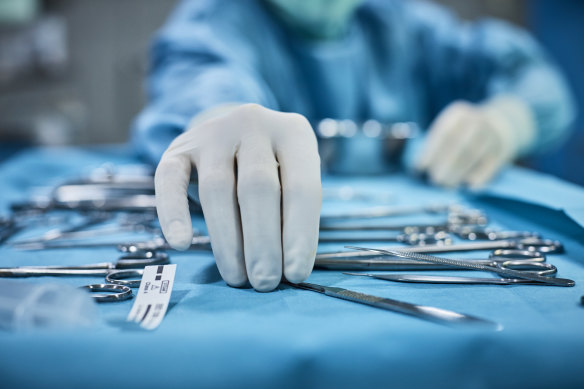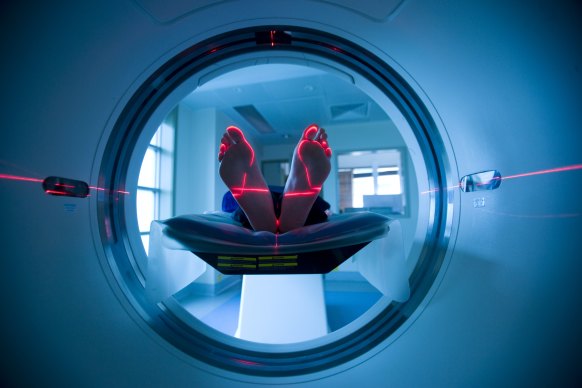‘I see scars’: Mel’s long and costly battle to restore her breasts – and identity
Mel Kuyl has been cancer-free for three years, but when she looks in the mirror she feels sick.
“I see scars,” the 42-year-old teacher said of the marks that run across her flat chest. “That’s all I see.”

Mel Kuyl has been waiting almost two years for breast reconstruction surgery following a double mastectomy.Credit: Wayne Taylor
After undergoing chemotherapy and a double mastectomy in 2021, followed by weeks of radiotherapy, the mother of two from Cobblebank in Melbourne’s west now needs reconstructive surgery to restore her breasts.
But she faces a lengthy and costly battle.
Surgeons have described the eight-hour operation as “medically necessary”.
But Kuyl has been on a public surgery waiting list at the Royal Melbourne Hospital since November 2022.
She has been quoted more than $12,000 in out-of-pocket costs to have the own-tissue breast reconstruction at a private hospital. This does not include additional out-of-pocket fees for the anaesthetist, expected to cost thousands of dollars.
Kuyl has held the second-highest level of health insurance for more than two decades, forking out $180 a fortnight in fees.
New data released this week by the Australian Prudential Regulation Authority shows that while privately insured patients access 87 per cent of in-hospital medical specialists services with no out-of-pocket costs, those paying gap fees are facing steep increases.
Out-of-pocket hospital fees soared by 7 per cent to an average of $437 in the year to June 30, according to an analysis of the data by private health insurance industry peak body Private Healthcare Australia, and are up 39 per cent over the past five years.

Women are waiting years for reconstructive surgery after having a mastectomy.Credit: iStock
Patients awaiting medically necessary plastic and reconstructive surgery faced the highest average out-of-pocket costs of any speciality, forking out an average $1553 – up from $1141 in 2019.
Lisa Pratt, from Cooranbong in the Lake Macquarie region of NSW, recently forked out $29,000 in out-of-pocket fees for a double mastectomy and reconstructive breast surgery following a BRCA2 diagnosis, which puts her at heightened risk of breast cancer.
Pratt, who lost her mother and aunt to breast cancer when she was a young woman, has always held the highest level of health insurance. She funded the surgery through crowdfunding and chipping into her savings.
“I cried for 24 hours after getting the invoice,” the 53-year-old.
“I was inconsolable. You have something here that is going to keep you alive, but it seems so out of reach.”
Kuyl has also launched a crowdfunding campaign to fund her surgery, which is booked to take place in a private hospital in October.
She would like to see Medicare rebates boosted for post-mastectomy breast reconstructions so patients don’t face such huge out-of-pocket fees.
Her surgery attracts a Medicare rebate of $5665, which she says is inadequate.
“It’s not something that is cosmetic,” she said. “It’s something that is putting me back together.”
Federal Health Minister Mark Butler said this year’s boost to Medicare rebates was the second-largest increase in the past 30 years, with the largest increase last year.

Health Minister Mark Butler says the Medicare rebate increases in the past two years are the two biggest ever – and private insurers and specialists have to do their part.Credit: Alex Ellinghausen
He called on the private health sector, including insurers and specialists, to do more to protect patients from exorbitant bills.
“All Australians deserve access to affordable healthcare. Examples like this are deeply concerning to me and all Australians,” he said.
David Goldsbury, a statistician from the Daffodil Centre – a Cancer Council NSW and University of Sydney joint venture – recently conducted Australia’s largest study of out-of-pocket costs incurred by cancer patients.

One in 10 people diagnosed in NSW with cancer spent $10,000 over the following 12 months on treatment. Credit: Nic Walker
The findings, which were published in the Medical Journal of Australia in July, revealed that one in 10 people with cancer in NSW spent more than $10,000 on healthcare in the first year following diagnosis.
“Breast and prostate cancers can have particularly high costs,” he said. “They were over-represented in the group that had out-of-pocket costs over $10,000.”
Cash-strapped patients are also seeking help from financial counsellors.

Demand for financial counselling at Cancer Council Victoria has exploded.Credit: Getty
Cancer Council Victoria has experienced a 79 per cent increase in demand for its financial counselling services in the past year, with 564 people referred to the service.
“Despite Australia’s universal health care system, cancer patients face many unexpected and hidden costs that can seriously impact them and their families,” said Amanda Piper, the organisation’s head of cancer strategy.
Private Healthcare Australia chief executive Dr Rachel David said health insurers worked hard to negotiate “no gap” fee arrangements with private hospitals to ensure members didn’t face out-of-pocket costs.
“It’s not possible for health funds to be continually chasing increasing fees with higher and higher reimbursement without contributing to inflation and pushing up premiums,” she said.
A Victorian government spokesman acknowledged that waiting for planned surgery could be challenging and frustrating. He said the government had reformed the delivery of surgery, including opening 10 rapid access hubs and creating two public surgical centres.
“Despite ongoing workforce challenges and increased demand, the planned surgery waitlist has dropped to below pre-COVID levels and patients are being treated faster across all categories,” he said.
Start the day with a summary of the day’s most important and interesting stories, analysis and insights. Sign up for our Morning Edition newsletter.